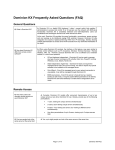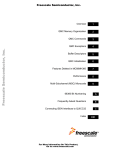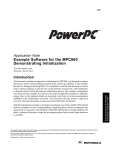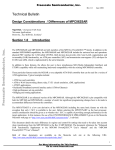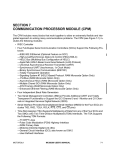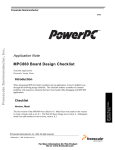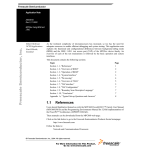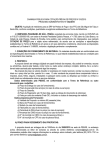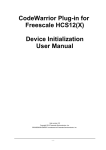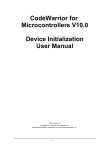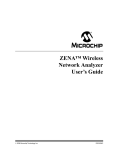Download Getting Started with MPC860
Transcript
29 MAY 98 Freescale Semiconductor Freescale Semiconductor, Inc... Application Note GETTING STARTED WITH THE MPC860: A Design Guide Netcomm Applications Freescale, Austin, Texas INTRODUCTION Hello, and welcome to designing with Freescale’s MPC860 PowerQUICC! We would like to thank you for choosing a Freescale processor. Freescale understands that in the field of integrated communications controllers, you have a choice. We’re proud to have your business. We’d like to introduce you to some resources available to you as an 860 designer. Then we’ll offer a step-by-step guide to developing hardware and software for the 860, and point out materials that may support your efforts. THE WEB The World Wide Web has fast become the most efficient way to provide a wide variety of support materials to customers. We invite you to visit our home on the web at: http://www.mot.com/netcomm The main NetComm home page tends to highlight new additions to the page and also contains the links to the other sections of the site. As a designer, it is more likely that you will © Freescale Semiconductor, Inc., 2004. All rights reserved. For More Information On This Product, Go to: www.freescale.com Freescale Semiconductor, Inc. find three other areas of our page most valuable: The Engineer’s Toolbox, the Publications Library, and the Support & FAQ area. The Engineer’s Toolbox Click on the TOOLBOX for example code, schematics, monitor packages, part models, initialization tools, and more. Files tend to be provided in a ZIP-compressed format or PDF format for Adobe’s Acrobat Reader. Freescale Semiconductor, Inc... Publications Library Click on PUBLICATIONS LIBRARY for our collection of users manuals, technical summaries, application notes (or “appnotes”), and user manual errata (listed as manual addendums). Also in this section you will find user’s manuals for our software, downloadable microcode packages, and our development systems. Support & FAQ Click on SUPPORT & FAQ to find the latest device errata, as well as find information on how to subscribe to our Mailing Lists which periodically broadcasts device news. The Frequently Asked Questions (FAQ) page provides a search engine that gives you the power to parse through actual helpline database issues on our products, accumulated over our years of experience. Why lose valuable time-to-market investigating a bug in your design if someone has already asked us about the same issue? When in doubt, check it out using the FAQ. Bookmark the link http://www.mot.com/netcommfaq to go directly to the FAQ search engine. THE MPC860 PowerQUICC USER’S MANUAL The MPC860 User’s Manual provides the most detailed information about the part and its operation. From I/O capabilities to programming models to interfaces, this is a must-have for anyone working with the 860. The manual’s document number is MPC860UM/AD and the manual can be obtained in electronic format from the Publications Area of the web page or through the Literature Distribution Center (discussed shortly). We are also pleased to announce the pending release of the new REV 1 edition of the 860 User’s Manual. This new edition has updated tables and diagrams, improved organization of the material, and new sections that better illustrate operation of the part to the reader. An Acrobat PDF version of the REV 1 manual is availble in the Publications Library of our website. 2 For More Information On This Product, Go to: www.freescale.com Freescale Semiconductor, Inc. PowerPC 32-Bit MICROPROCESSOR MANUAL This manual complements the MPC860 PowerQUICC User’s Manual by going into great detail on such topics as the PowerPC register set, exceptions, and the PowerPC instruction set. The document number is MPCFPE32B/AD. Freescale Semiconductor, Inc... THE MPC860 TRAINING CDROMS NetComm is producing another valuable tool that will assist to educate yourself on the operation of the MPC860. Derived directly from the 4-day training course available from Freescale, NetComm is making available a set of MPC860 Training CDROMs. Certainly you can use them to train yourself before you begin your design, but these discs should also prove to be a handy reference once your design is underway. This training set introduces a wealth of information to the new designer as well as serve as a collection of insights to reinforce the knowledge of the experienced engineer. There are many ways in which you might want to use this training. The information has been arranged in a sequential fashion, so if you desire, you may proceed through the course from start to finish as though you were actually taking the class. It is also possible to use the Table of Contents or the Keyword Index to randomly access the material as if you were thumbing through a manual. This CDROM set will be available through Freescale’s Literature Distribution Center, beginning in June 1998 (estimated). THE NETCOMM GENERAL INFORMATION CD-ROM Tired of downloading large documents from our web-site? We offer user’s manuals and large software packages such as the MCUinit processor initialization tool in a CD-ROM format. While everything that is contained on this CD-ROM is also located on the web, this disc may be more convenient for those customers with low-bandwidth access to the internet. This disc may be obtained by contacting Freescale’s Literature Distribution Center using the methods described in a moment, and requesting item CDRONETCOM/D. Use the web for downloading smaller documents, and documents which could change frequently. THE LITERATURE DISTRIBUTION CENTER Hard copies of our manuals and CD-ROMs can be obtained by contacting Freescale Semiconductor Product Sector’s Literature Distribution Center (LDC). The LDC’s web page can currently be accessed through the Literature Retrieval area of: http://www.mot-sps.com/sps/General/sales.html Additional contact information is as follows: USA/Europe/Locations Not Listed 3 For More Information On This Product, Go to: www.freescale.com Freescale Semiconductor, Inc. P.O. Box 5405, Denver, Colorado 80217 1-800-441-2447 or 1-303-675-2140 Japan Nippon Freescale Ltd.: SPD Strategic Planning Office 4-32-1, Nishi-Gotanda, Shinagawa-ku, Tokyo 141, Japan 81-3-5487-8488 Freescale Semiconductor, Inc... Asia/Pacific Freescale Semiconductors H.K. Ltd. 8B Tai Ping Industrial park 51 Ting Kok Road, Tai Po, N. T., Hong Kong 852-26629298 STEP-BY-STEP GUIDE TO DESIGNING WITH THE MPC860 IS THE 860 RIGHT FOR YOUR APPLICATION? With the complexity of chips these days, it can take a lot of time to make sure that a given chip is right for your board. Here are some steps you can take to make sure the MPC860 is right for you. 1. Look at the MPC860 variations. Go to http://www.mot.com/netcomm and click on the PRODUCTS icon. On the PRODUCTS page you will see a list of MPC860 variations. Click on one of the variations and you will see a table that illustrates the differences between the versions. 2. Obtain the right user’s manuals. All the MPC860 family members require the MPC860UM/AD which is available from the web, from our CD ROM called CDRONETCOM/D, and from the Literature Distribution Center. If you want information on the MPC860MH, MPC860DH you will also need the QMC User’s Manual supplement. If you need the MPC860SAR, you will want its supplement. If you want the MPC860T, you will want its supplement that shows the differences between the base MPC860 and that particular device. If you are looking at one of the MPC850 family members, you would start with the base MPC850 manual instead of the MPC860 manual. 3. Read the introduction section of the user’s manuals. This will give you an overview of the features of the chips. If you are looking at the MPC860DC (dual channel device) or MPC860DE (dual Ethernet) devices, then the MPC860 4 For More Information On This Product, Go to: www.freescale.com Freescale Semiconductor, Inc. base manual still applies, but only SCC1 and SCC2 are available. SCC3 and SCC4 pins can still be used as parallel I/O ports, but the SCC3 and SCC4 are non-functional. 4. Choose the Right Part for your Communications Functions The next area to investigate is whether the communications functions on the MPC860 are right for your application. Decide what serial functions you want to accomplish at the same time. For example you may want Ethernet, HDLC and UART. Freescale Semiconductor, Inc... You could assign SCC1 = Ethernet SCC2 = HDLC SCC3 = UART Since Ethernet is one of the choices, this rules out the “MPC860”, leaving the MPC860DC, MPC860DE, MPC860DH, MPC860EN and MPC860MH. If the HDLC support is multi-channel such as 24/32 time slots on fractional T1/E1 or several ISDN BRI’s, this narrows the choice to the MPC860DH or MPC860MH. This protocol is called Quicc Multi-Channel Controller (QMC) in our documentation. Now the choices become: MPC860MH SCC1 = Ethernet SCC2 = Multi-channel HDLC (also called QMC) SCC3 = UART But wait, the MPC860DH only has 2 SCCs! Can it be used? Yes, because it has 2 SMCs also, which are capable of low speed UARTs! So the MPC860DH is also possible: MPC860DH SCC1 = Ethernet SCC2 = Multi-channel HDLC SMC1 or SMC2 = UART Finally, it should be noted that the functions on SCC1 and SCC2 can be switched if needed on parts that offer Ethernet on more than one channel such as the MPC860MH and MPC860DH. What about the MPC850? Can it be used. The MPC850DH offers less CPU performance and less capable communications functions, but the necessary functions can still be mapped as follows: MPC850DH SCC2 = Ethernet SCC3 = Multi-channel HDLC 5 For More Information On This Product, Go to: www.freescale.com Freescale Semiconductor, Inc. SMC1 = UART From reading section 1 of the MPC850DH manual, you will see that even though this part has 2 SCCs, they are actually “SCC2 and SCC3” since SCC1 is replaced with a dedicated USB controller. In addition the MPC850DH only has one SMC that can be connected to its own set of pins, so only SMC1 is possible. Conclusion: So far, our most realistic options for this application are the MPC860DH and the MPC850DH. Can both be used? It probably depends on the CPU performance required, which is discussed later. For now, let’s stick with the MPC860DH for our example. Freescale Semiconductor, Inc... 5. Check the Pinout of the Desired Part In our example, we need to make sure that the MPC860DH will all the pins operating simultaneously to support: MPC860DH SCC1 = Ethernet SCC2 = Multi-channel HDLC SMC1 or SMC2 = UART A reading of the Ethernet section of the manual shows us that the following pins are required if Ethernet is used on SCC1: TXD1 TENA which is mapped onto RTS1 TCLK which must be mapped to CLK1, CLK2, CLK3 or CLK4 RXD1 RENA which is mapped onto CD1 RCLK which must be mapped to CLK1, CLK2, CLK3 or CLK4, but must be a different pin than the one used for TCLK above CLSN which is mapped onto CTS1 Now go to the Signals Description of the Manual and look for those signals and circle them. Now for the Multi-Channel HDLC support. This requires a time-slot assigner A or time-slot assigner B. Which one should we use? You can use either -- whichever makes the rest of the pin assignment easier. For this example, lets assume that the receive and transmit sides are completely independent and therefore require their own separate clocks and synchronization pins. Then the pins we need are: Choice 1 is TDM A L1TXDA L1RXDA L1TCLKA L1RCLKA L1TSYNCA 6 For More Information On This Product, Go to: www.freescale.com Freescale Semiconductor, Inc. L1RSYNCA Choice 2 is TDM B L1TXDB L1RXDB L1TCLKB L1RCLKB L1TSYNCB L1RSYNCB Freescale Semiconductor, Inc... Note that these pins are easily distinguished from other SCC functions because they all start with L1 (Layer 1). If only one clock and one sync was needed then only L1RCLKx and L1RSYNCx would be used. Now go to the Signals Description of the manual and look for these signals and circle them. For our example, we will choose TDM A rather than TDM B. What you will notice is that L1RCLKA is an alternate function of CLK1 and L1TCLKA is an alternate function on CLK3. Thus, we should go back to our Ethernet selections above, and choose CLK2 and CLK4 so there is no conflict. Another interesting thing to note is that L1TSYNCA and L1RSYNCA are available in 2 places on the device! You can pick either location, and select it later in your software initialization. Why did we do this? In a few case studies we did, we found that certain key applications required this kind of flexibility, otherwise we would not have added this extra complication to the device! Lastly, we need to select an SMC to use for the UART. Either SMC1 or SMC2. Thus our choices are: SMTXD1 SMRXD1 or SMTXD2 SMRXD2 Note that the use of the SMCs means that we do not have RTS, CTS and CD functions. (If you must have those functions, and software interrupts are not sufficient, then an SCC must be used, putting the application back to an MPC860MH rather than the MPC860DH.) An examination of the pinout reveals that indeed, everything fits on the MPC860DH, and it really didn’t matter which SMC we chose, and which TDM we chose in this case. As you start to use more channels, and more of the “optional” signals on certain interfaces, the chances of a contention increases. 6. Check the Dual-port RAM of the Desired Part 7 For More Information On This Product, Go to: www.freescale.com Freescale Semiconductor, Inc. So now we know that the MPC860DH supports the simultaneous use of all the pins we need. SCC1 = Ethernet SCC2 = Multi-HDLC (also called QMC) on TDM A SMC1 = UART Freescale Semiconductor, Inc... What is the next resource that could be a problem? The answer is the Dual-port RAM. Each protocol requires certain parameters that are stored in the dual-port RAM. In the case of certain complicated protocols like Ethernet and Multi-HDLC the parameter RAM requirement is so large that it actually overruns the parameter RAM of other protocols. In our example Ethernet on SCC1 overruns the I2C area, and QMC on SCC2 overruns the SPI area. To solve this we have several downloadable microcodes that “patch” this problem by moving I2C and SPI parameter RAM to other locations. This is called the “Microcode Patch for Relocating 12C/SPI Parameters” and is available from the ENGINEERS TOOLBOX on our web-site. 7. Check the CPM Performance Now that the pins and dual-port RAM requirements are checked to be OK for our application, we need to check that the Communications Processor Module (CPM) performance is sufficient for the application. The method used to determine this is illustrated in the User’s Manual Appendix A, and involves a simple equation based upon the system clock speed of the 860, as well as the protocols required and their speeds. This Appendix lists the maximum expected performance of the 860 at 25 MHz for each kind of functionality the 860 provides. This chart scales linearly, so as an example, if you intend to run the 860 at 50MHz, then these maximum bandwidth numbers also double. We also offer an Excel spreadsheet called “CPM Performance Spreadsheet” that performs these CPM loading calculations for you and it is located in the Engineer’s Toolbox of our web page. This is a very useful tool! To perform these calculations by hand, simply divide the intended bandwidth of a certain protocol by the maximum, repeat for any additional functions you will be using, add all these fractions together, and do not exceed a sum of 1. Let’s do a quick example to illustrate what we are describing. If the 860 were operating at 25MHz, and would be using a 10Mbit Ethernet channel in half duplex, a 2Mbit HDLC channel, a 64 Kbit HDLC channel, a 9.6 Kbit UART and a 38Kbit SMC UART, you would take these bandwidths, divide them by the max for each protocol, and sum them as follows: 10/22 + 2/8 + 0.064/8 + .0096/2.4 + 0.038/0.22 = 0.96 which comes close to, but does not exceed 1. So the processor would not be overloaded. 8 For More Information On This Product, Go to: www.freescale.com Freescale Semiconductor, Inc. If you were to attempt 32 QMC channels at 64 Kbit each and one additional 2Mbit channel with the 860 at 25MHz, the following equation applies: (32 * 0.064)/2.1 + 2/8 =1.22 This arrangement will not work. You can, however, keep this arrangement if you increase the operating speed of he 860 to 33MHz. 1.22 * 25/33 = 0.92 Freescale Semiconductor, Inc... Now the CPM is not overloaded. 8. Check the PowerPC CPU Performance The last main area of concern is the CPU Core Performance. Our CPU offers the following Dhrystone MIPS performance: At 66 Mhz, the 860 performed 87 Dhrystone MIPS At 50 MHz, the 860 performed 66 Dhrystone MIPS At 40 MHz, the 860 performed 52.8 Dhrystone MIPS At 33 MHz, the 860 performed 43.56 Dhrystone MIPS At 25 MHz, the 860 performed 33 Dhrystone MIPS These numbers were obtained with a Diab Compiler. The good news about the Dhrystone benchmark is that the results for it, are available from a wide variety of processors. The bad news about the Dhrystone benchmark is that it fits completely in internal cache of 2K instructions or greater. Thus, the Dhrystone benchmark shows the 4K/4K (instruction cache/data cache size) MPC860 family to be the same speed as the 2K/1K MPC850 family. In actuality the performance of the MPC860 is 10-35% greater than the MPC850 family at the same clock speed. Another metric commonly used for the MPC860 is that this processor is about 10% faster than the 68040 processor at the same clock speed (which also has 4K/4K cache). Finally, our TOOLBOX offers a benchmark “shell” which allows you to benchmark your own code on our processor. This shell of code initializes the chip, turns on the MMU and Caches, and starts a timer for you. It also shows you where to place your own “test code” to see how long it takes to run. The example code that is included in this shell is the Dhrystone code. 9. Price and Availability This information is not available on our web site, so check with your local distributor or Freescale representative. Freescale’s main distributors are Arrow, Future, Hamilton-Hallmark and Wyle. Our web site does contain press releases which show the “direct from Freescale” 9 For More Information On This Product, Go to: www.freescale.com Freescale Semiconductor, Inc. pricing at the time of the device announcement, however pricing does change drastically with volume and with time. STEP-BY-STEP GUIDE FOR HARDWARE DESIGNERS Now that you have decided to actually use the MPC860 in a design, the following steps are recommended. Freescale Semiconductor, Inc... 1. Determine the memory system you will need. The MPC860 is a bursting device and thus obtains the best performance when the memory it is connected to is also able to burst. The MPC860 burst is comprised of four 32-bit words. If the length of the burst is written as 4-2-2-2, then the first 32-bits were read/written in 4 clocks, the next 32-bits in 2 clocks, and so on for a total burst length of 10 clocks. The following table shows some example burst lengths for a BURST READ operation. (BURST WRITES are usually slightly better). Note that faster memory can yield better results. Also note that for the 66 Mhz devices (or any device used in half speed bus mode) the actually bus speed may only be one half of the processor speed. Thus a 66 Mhz device might only have a 33 Mhz external bus. Whether a 66/33 (internal/external) device is faster than a 50/50 device will depend on the cache hit rate and the external memory speed. More information on the various memory types can be obtained in the following collection of appnotes: 10 For More Information On This Product, Go to: www.freescale.com Freescale Semiconductor, Inc. MPC860 Interface to Fast Page Mode DRAM MPC860 Interface to EDO DRAM MPC860 Interface to Synchronous DRAM (SDRAM) 2. Obtain Example Schematics Freescale Semiconductor, Inc... The web site offers several sources of example schematics available in ORCAD format. The most useful set is probably the SAMBA schematics, which shows how to interface the entire MPC860 family to memory -- Flash EPROM, DRAM, and SDRAM. In addition, it shows the MPC860T connected to an external 10/100baseT Transceiver. In addition, the schematics for our MPC860FADS boards are also available, however, this board is designed to be very flexible, and may not represent the most efficient system design. 860 PART SYMBOL: An 860 electronic part symbol in ORCAD Capture format is also on the web. BGA FOOTPRINT: The documents AN1231 and AN1232 are in-depth discussions about factors regarding the BGA package that the 860 uses and includes a footprint for design purposes. 3. Obtain User’s Manual Errata and Device Errata This information is available on our web site in the PUBLICATIONS and SUPPORT & FAQ sections respectively. 4. Remember the 5V Tolerance Although the MPC860 family is a 3.3V supply device, it is 5V tolerant and can be used with 5V TTL compatible components. 5. Look at Clocking Issues Although the part allows both crystals and oscillators to be used, we recommend oscillators to be used if possible. Oscillators reduce the risk of process variations or process shrinks from causing the clocking circuit to cease operation. For those that must use crystals, we recommend that engineers inquire to their crystal manufacturer to determine the best capacitor and crystal characteristics. They are in the best position to estimate the values needed for the circuit. We do provide the appnote “Crystal Note for the 302, 360 and 8XX Family.” This paper is written to assist engineers in the production of reliable clock circuits which may be used with 11 For More Information On This Product, Go to: www.freescale.com Freescale Semiconductor, Inc. devices such as the MPC860, MC68360 and MC68302 and their derivatives. It discusses in general terms various methods for the generation of the system clock. 6. Look at Pin Termination A frequent issue of concern is the proper termination of signal pins. This is the most common reason why a MPC860 board does not work at power-up. Which pins should be pulled up or down for proper operation of the 860? Please see the External Signals section of the new MPC860 manual, found in the Publications Area of the web. Freescale Semiconductor, Inc... 7. Look at Pin Timing Issues When designing your circuits involving the 860 you will obviously take care to meet the timing specifications of the 860. In addition to the timing diagrams in the 860 manual, we also provide some additional tools to help understand your timing needs. On the web, in the Publications Area, is the MPC860 Electrical Specifications Spreadsheet. This Excel document dynamically calculates timing specifications based upon operation speed and capacitive loading. You can program the exact frequency of your system bus, and this tool will customize the MPC860 timings for you. In addition, you can program the capacitive loading on the pins, and the tool will customize the timings. We also have available an electronic data book of the 860 timings that can be used with Chronology’s TimingDesigner tool. This software aids in visualizing signal waveforms and timings. For details, contact Kevin Silver at Chronology at 1-800-800-6494 ext.113. 8. Check the Hardware Configuration Register Carefully The MPC860 has a number of different modes that can be programmed in hardware. You select the modes by driving certain voltage levels onto the Data Bus pins during reset. Any Data Bus pins that you do not drive will take on the default configuration. Out of the 15 or so pins, you will probably only need to drive 4 or 5 -- the rest can use the defaults. Please read this section of the manual very carefully as you are making very basic decisions about the operation of the part. 9. Read the Design Checklist When you think you have everything under control, go back and read the MPC860 Design Checklist which resides in the PUBLICATIONS section of our web site. This gives a number of helpful hints and lists some common mistakes. 10. Get the part up and running. 12 For More Information On This Product, Go to: www.freescale.com Freescale Semiconductor, Inc. When you get the boards back, the first thing you should do is bring the part up in its debug mode. In the debug mode, you can control the part through the debug port without requiring the device to execute any software on the board itself. The debug port pins of the MPC860 should be brought to a simple header that is described in the APPLICATIONS section of the MPC860 User’s Manual. This will allow many standard debuggers to access the device. In fact, if you purchased an MPC860 FADS board, you can use our MPC8bug on the host PC to control to your target board through the MPC860 FADS board. See the MPC860FADS manual for more information on this option. 11. Having Trouble? Freescale Semiconductor, Inc... Don’t forget to check the searchable FAQ at: http://www.mot.com/netcommfaq for hints on what might be wrong. 12. Get on the MPC860-Update List Server See the SUPPORT & FAQ section of our web site to subscribe to get real-time updates of late breaking news on the MPC860. STEP-BY-STEP GUIDE FOR MECHANICAL AND COMPONENT ENGINEERS Here are some additional steps to consider. 1. Read the Packaging Appnote The MPC860 family resides in a 357 lead Plastic Ball Grid Array (PBGA) package. An appnote for the use of this package and PBGAs in general may be found at: http://www.mot.com/pbga 2. Look at Thermal Considerations NetComm is soon making available in the Publications Area a new appnote covering thermal considerations and measurements for the 860 and its packages. If extended temperature (-40 to +85) is required, may not be offered in at all speed grades, and may require heat sinks at the highest speed grades. 3. Look at Power Dissipation 13 For More Information On This Product, Go to: www.freescale.com Freescale Semiconductor, Inc. The MPC860 family tends to vary from 0.4W to 0.8W depending on frequency. The power dissipation at a given frequency is decreasing as the device undergoes shrinks. Meanwhile the offered frequency is increasing over time. The end result is that the power dissipation for the highest speed versions tend to be in the 0.8W range. The first MPC860 User’s Manual showed an option of running the internal circuitry of the MPC860 family at 2.2V (rather than 3.3V) to save power. This option has NOT been productized in the MPC860 or MPC850 family, and is not available. Freescale Semiconductor, Inc... 4. Qualification Data Qualification reports are available for our devices, however they can only be obtained through a Freescale Sales office. STEP-BY-STEP GUIDE FOR SOFTWARE DESIGNERS 1. Determine Your Tool Set An incredible amount of support is also available in many forms from companies outside of Freescale. A list of those companies organized by category of support, their contact information and links to their web sites (if available) are located on our web site. At the top of various pages throughout our web site you will see links to the 860 Third Party Support Page. Categories of support include: Board Test Consultants, Chip Drivers (Software), Generators and Tools, Companion or Support Chips, Development Systems, Emulators, Hardware Models, Network Software, Operating Systems, and Package & Socket Adapters. We highly encourage you to investigate these companies products and services in your efforts to get your product to market. 2. Review the Freescale Application Development System Materials Among the most important support materials available to our customers is the MPC8xx Family Application Development System (8xxFADS). This package is meant to serve as a platform for software and hardware development around the 860 family of devices. Using the on board resource and the associated MPC8bug debugger/monitor, a developer is able to load their code, run it, set breakpoints, display memory and registers and connect the developer’s own proprietary hardware via the expansion connectors. The FADS is not just effective for testing purposes but can also serve as a demonstration tool. Contact your local Freescale Sales office for details on how to purchase the systems. Information on how to find the most appropriate sales channel can be found on the web. MPC8BUG 14 For More Information On This Product, Go to: www.freescale.com Freescale Semiconductor, Inc. Freescale provides its own command line debugger/monitor program called MPC8bug. This package provides excellent simple methods of observing and debugging your code and performing diagnostics. You can even write your own diagnostics with the new 1.3 release of the software. This software is shipped with the 860ADS or 8xxFADS, and is also available on the web. 3. Acquire MCUinit Freescale Semiconductor, Inc... Interested in using a graphic interface tool to quickly produce initialization code for the 860? You need to check out MCUinit, a menu-driven initialization code generating program for 32bit Windows compatible computers. This software package is located both on the web and on the NetComm General CDROM. 4. Study Exception Processing and Interrupts There is also the MPC860 EPPC Exception Processing Application Note with deals with exception processing in more detail. In addition, two appnotes are provided on interrupts -- one for the SIU and one for the CPM. 5. Obtain Basic Chip Initialization Code Look in the ENGINEERS TOOLBOX on the web to obtain the latest MPC860 Initialization code. This shows how to bring the device up from power-up including the programming of clocking modes and chip selects. 6. Obtain Device Drivers and Example Code The Engineers’ Toolbox is your best resource for freeware available from Freescale for use with the 860. On the web you will find both simple tutorial-style examples, and some complex drivers as well, that demonstrate a wide variety of protocols and modes of operation from setting up timers to running Ethernet. The list of code available is being updated all the time, so check the web often. We currently have drivers or example code for HDLC, Ethernet, UART, Transparent, Real-time clock, I2C, the PowerPC Timebase, ATM SAR for the MPC860SAR. Drivers are also available for a fee from third parties such as AISYS, Inverness, and Trillium and are often included with a purchase of an RTOS for the MPC860. 7. Read the CPU Performance Appnote The MPC860 core has two Memory Management Units and two caches, one of each for data and for instructions. We invite you to study our Cache and MMU appnote package, available in the Publications area of the NetComm web site, which explains how to efficiently use the 15 For More Information On This Product, Go to: www.freescale.com Freescale Semiconductor, Inc. caches and MMU. It includes the appnote itself, a special version of the debugger/monitor NetComm offers with cache hit simulation ability, and some scripts (given as examples in the appnote) that can be used with the debugger. The appnote is named “MPC8XX Performance Driven Optimization of Caches and MMUs”. 8. Scan the Performance Checklist Freescale Semiconductor, Inc... In the Publications Library is the MPC860 CPU Performance checklist. This document is basically a quick summary of the most important facets of the Performance Appnote mentioned above. Topics that are covered include dealing with DRAM, interrupts and their handlers, core operation modes and more. If you are not getting the performance you expect, this is the place to start. The MPC860 has so many debug assist modes that it is not uncommon for customers to see a 2x to 3x performance improvement, after following the guidelines in this checklist. 9. Having Trouble? If you are having trouble getting your serial protocols to work try looking at the appnote “Hints for Debugging the CPM”. This shows you how to determine where the problem resides, by showing you how to trace the flow of data from system memory to the pins, and from the pins to system memory. Also, don’t forget to check the searchable FAQ at: http://www.mot.com/netcommfaq 10. Get on the MPC860-Update List Server See the SUPPORT & FAQ section of our web site to subscribe to get real-time updates of late breaking news on the MPC860. 16 For More Information On This Product, Go to: www.freescale.com Freescale Semiconductor, Inc. How to Reach Us: Home Page: www.freescale.com Freescale Semiconductor, Inc... E-mail: [email protected] USA/Europe or Locations Not Listed: Freescale Semiconductor Technical Information Center, CH370 1300 N. Alma School Road Chandler, Arizona 85224 +1-800-521-6274 or +1-480-768-2130 [email protected] Europe, Middle East, and Africa: Freescale Halbleiter Deutschland GmbH Technical Information Center Schatzbogen 7 81829 Muenchen, Germany +44 1296 380 456 (English) +46 8 52200080 (English) +49 89 92103 559 (German) +33 1 69 35 48 48 (French) [email protected] Japan: Freescale Semiconductor Japan Ltd. Headquarters ARCO Tower 15F 1-8-1, Shimo-Meguro, Meguro-ku, Tokyo 153-0064 Japan 0120 191014 or +81 3 5437 9125 [email protected] Asia/Pacific: Freescale Semiconductor Hong Kong Ltd. Technical Information Center 2 Dai King Street Tai Po Industrial Estate Tai Po, N.T., Hong Kong +800 2666 8080 [email protected] For Literature Requests Only: Freescale Semiconductor Literature Distribution Center P.O. Box 5405 Denver, Colorado 80217 1-800-441-2447 or 303-675-2140 Fax: 303-675-2150 [email protected] 17 Information in this document is provided solely to enable system and software implementers to use Freescale Semiconductor products. There are no express or implied copyright licenses granted hereunder to design or fabricate any integrated circuits or integrated circuits based on the information in this document. Freescale Semiconductor reserves the right to make changes without further notice to any products herein. Freescale Semiconductor makes no warranty, representation or guarantee regarding the suitability of its products for any particular purpose, nor does Freescale Semiconductor assume any liability arising out of the application or use of any product or circuit, and specifically disclaims any and all liability, including without limitation consequential or incidental damages. “Typical” parameters which may be provided in Freescale Semiconductor data sheets and/or specifications can and do vary in different applications and actual performance may vary over time. All operating parameters, including “Typicals” must be validated for each customer application by customer’s technical experts. Freescale Semiconductor does not convey any license under its patent rights nor the rights of others. Freescale Semiconductor products are not designed, intended, or authorized for use as components in systems intended for surgical implant into the body, or other applications intended to support or sustain life, or for any other application in which the failure of the Freescale Semiconductor product could create a situation where personal injury or death may occur. Should Buyer purchase or use Freescale Semiconductor products for any such unintended or unauthorized application, Buyer shall indemnify and hold Freescale Semiconductor and its officers, employees, subsidiaries, affiliates, and distributors harmless against all claims, costs, damages, and expenses, and reasonable attorney fees arising out of, directly or indirectly, any claim of personal injury or death associated with such unintended or unauthorized use, even if such claim alleges that Freescale Semiconductor was negligent regarding the design or manufacture of the part. For More Information On This Product, Go to: www.freescale.com


















